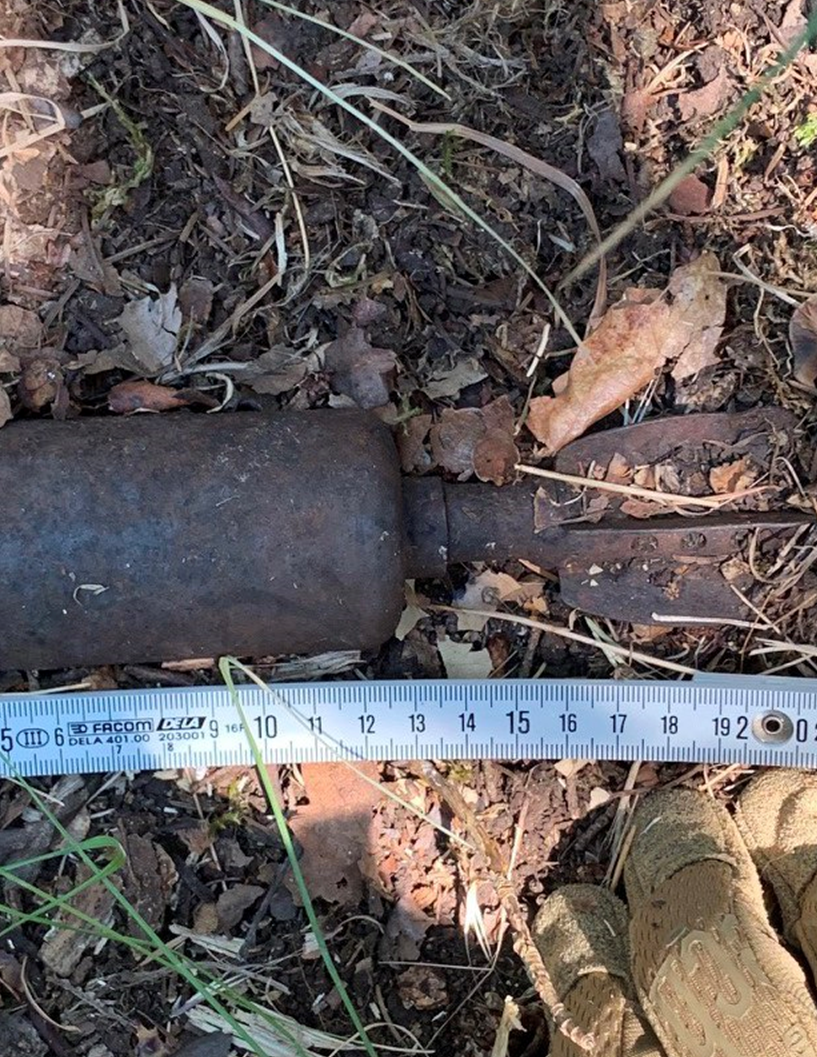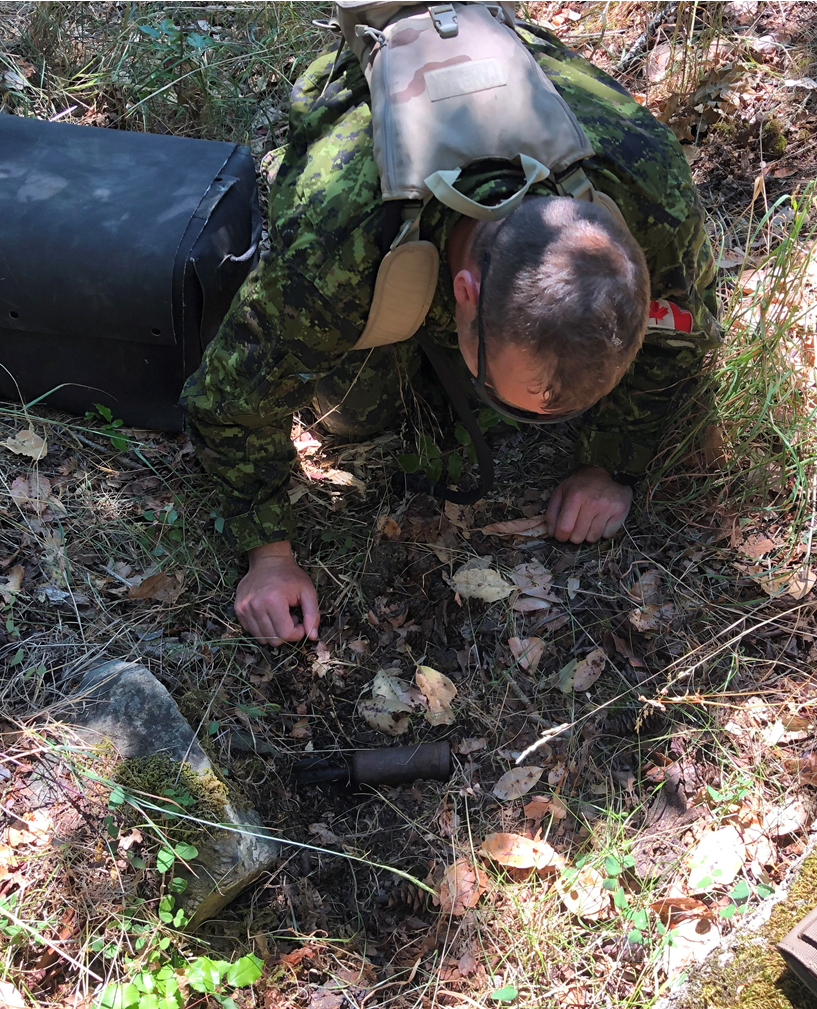Unexploded Second World War-era mortar discovered at Fort Rodd Hill, Vancouver Island
A groundskeeper at the Fort Rodd Hill National Historic site in Colwood got more than they bargained for when they unearthed an unexploded mortar.
The Parks Canada worker was clearing invasive plants from an unused part of the site when he discovered a more than 80-year-old shell.
The mortar was located partly under the ground of a rocky, heavily wooded gully not open to the public.
“It was only a fluke that one of our maintenance people happened to be there,” said Kate Humble with Parks Canada on Wednesday. “This was found in a location where the public never goes and is even rarely trafficked by our own team.”
Humble says the staff member immediately called their manager and the area was cordoned off. Parks Canada staff then notified authorities at CFB Esquimalt of the discovery.
“We got a call from the MP’s on base that a two-inch mortar was found at Fort Rodd Hill,” said Maritime Explosive Ordnance Chief, Fleet Diving Unit Pacific PO First Class (RCN) Sebastian Guay.
 The 1930's-era mortar found at Fort Rodd Hill is shown: (Department of National Defence)
The 1930's-era mortar found at Fort Rodd Hill is shown: (Department of National Defence)
(Department of National Defence)
“The round itself didn’t have a fuse in it but it is unclear whether it had live explosives in it or if it was an old training one. It was so old it was too hard to identify,” he said.
Fort Rodd Hill was established in the mid-1890’s as a coastal defence bastion by the Royal Navy. It continued as a key part of Canada’s West Coast Defence network and as a military training installation during the First and Second World Wars.
It was decommissioned as a military facility in 1956 and was handed over to Parks Canada in the early 1960’s to establish it as a National Historic site. Prior to the installation's decommissioning, the grounds of the site were swept extensively for unused military munitions.
“It’s extremely unusual to find something like (a mortar) on this site,” said Humble. “A thorough sweep of this site was done repeatedly to ensure that unexploded ordinance wasn’t going to be found here.”
Humble says the 1930’s-era shell was extremely degraded and there were no identifiable markings on it.
“It was difficult for us to read any markings on it. However, mortars have a very distinctive shape so we could visually identify it,” she said.
“It's been there a long time, I can only assume, and there was never a danger to the public at anytime.”
 The 1930's-era mortar found at Fort Rodd Hill is shown: (Department of National Defence)
The 1930's-era mortar found at Fort Rodd Hill is shown: (Department of National Defence)
(Department of National Defence)
Guay says it is possible the mortar shell was used in training in the years leading up to the Second World War.
“Back in the day they used to carry the live stuff with them, without the fuse, when they were training,” said Gauy. “They could still fire them without the fuse in them and sometimes they just forgot to put the fuse in them.”
Guay says the team of two Navy ordinance disposal experts are highly trained professionals with many years of experience. Once the team determined the unexploded mortar could be safely moved it was secured.
“It was put in a 'blast bag' which can sustain the explosion in case it goes off,” said Guay. “They took it to a bomb disposal range and blew it up as soon as they got there.”
Guay says the members of the Ordinance Disposal Unit of the Fleet Diving Unit Pacific respond to close to 150 unexploded military ordinance calls a year. He says most of the calls for the expertise of the CFB Esquimalt-based unit come from the Vancouver area.
Guay says should people discover an item that looks like a bomb, it likely is a bomb.
“Don’t touch it or move it,” he said. “If it is possible, take a picture of it, back away and call the RCMP. The RCMP will call the regional joint operation centre which is here on base and they’ll let us know we have a call to answer.”
CTVNews.ca Top Stories

'There is no electricity': Canadian travellers in Cuba urge caution in hurricane's wake
Cuba's power grid was knocked out by Hurricane Rafael, which ripped across the country as a Category 3 storm. In western Cuba, it toppled buildings and pushed 50,000 people to find shelter elsewhere. Cubans were already enduring rolling blackouts due to energy shortages.
Sparks fly as MPs question minister on pension implications of proposed election date change
Sparks flew at a parliamentary committee Thursday as MPs questioned Canada's democratic institutions minister about a widely opposed provision in electoral reform legislation that seeks to delay the next fixed election date by one week.
Three charged in One Direction singer Liam Payne's death
Three people have been charged in relation to One Direction singer Liam Payne's death, an Argentine prosecutor's office said on Thursday, after the superstar fell from his hotel balcony last month.
America votes: How celebrities are reacting to Trump's decisive victory
Celebrities from Hulk Hogan to Ariana Grande are sharing their reactions to the U.S. election, which will see Donald Trump return to the White House.
Biden delivers remarks following Trump's win
U.S. President Joe Biden delivered remarks to the nation Thursday in what was his first appearance on camera following Donald Trump’s decisive victory over Kamala Harris.
RCMP already 'on high alert' for potential wave of migrants after Trump election
Canada's federal police force has been preparing for months on a contingency plan for a potential massive influx of migrants across the border following Trump's promise of 'mass deportations' of millions of undocumented immigrants in the U.S.
BREAKING 3 Winnipeg police officers charged with breach of trust, theft
Three members of the Winnipeg Police Service have been charged with breach of trust, obstruction of justice and theft following a lengthy investigation
PM Trudeau revives Canada-U.S. relations cabinet committee after Trump win
Prime Minister Justin Trudeau is reviving a special cabinet committee dedicated to Canada-U.S. relations, following Republican Donald Trump's re-election.
New DNA evidence rewrites long-told stories of people in ancient Pompeii
When a volcanic eruption buried the ancient city of Pompeii, the last desperate moments of its citizens were preserved in stone for centuries.


































